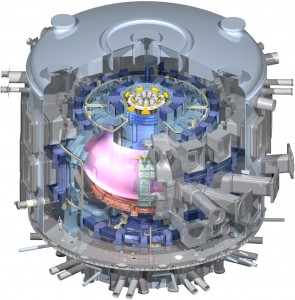Top Ten Reasons for ITER
As climate change becomes a serious national security threat, we must look to the future for a clean, safe and sustainable source of energy for our future.
The ITER experiment will be the largest  experimental tokamak nuclear fusion reactor, located at Cadarache, France.
experimental tokamak nuclear fusion reactor, located at Cadarache, France.
Through ITER, we can find solutions to control fusion energy, so that it can be commercialized to provide the world with a sustainable energy source.
This project was born in 1985 in hopes of peace through energy cooperation between the superpowers of the Soviet Union and the U.S. Today, its members include China, the European Union, India, Japan, the Republic of Korea and the United States of America.
With recent controversy over the mismanagement of the ITER structure, the U.S. has reevaluated its position in funding the ITER project. If the U.S. withdraws from the project, we will fall behind in energy research and will not be able to reap theITER numerous benefits that ITER offers.
Below are the top ten reasons why ITER is beneficial for the United States
1. ITER is a great return on investment: The U.S. only contributes about 9% but reaps 100% of what ITER produces.
2. ITER provides business opportunities: About 80% of the funds for the ITER project is spent within the U.S.[1]
3. U.S. business would be exporting large amounts of goods: U.S. businesses are not only getting contracted by U.S. ITER but by other ITER members. One example is the Oxford Superconducting Technology. Located in New Jersey, it was awarded over $55 million by the EU for torodial field strand production.[2]
4. The ITER project engages U.S. industries, universities and national laboratories: ITER stems from a wide range of natural science and engineering fields which provides many different opportunities for a variety of fields to be in conjunction with each other.
5. It creates jobs: The ITER Organization predicts between 2014 and 2017 there will be around 3,000-4,000 workers added to the existing 1,000 employees.[3]
6. ITER provides future large investments in the U.S.: The project anticipates an estimate of $1 Billion in future contracts for the United States.[4]
7. Keeps America competitive: Participating in the ITER project prevents the U.S. from falling behind on new frontiers of science.
8. ITER is a method of practicing diplomacy through energy: During the Cold War, Mikhail Gorbachev saw fusion energy as a solution to get the Soviet Union and the U.S. to cooperate. If the U.S. withdraws from the project, it will lose international credibility.
9. Most of the U.S. is involved: ITER contracts extend over 38 states, which have been awarded for $10,000 or more.[5]
10. ITER provides a solution to the energy crisis: Fusion provides,clean limitless energy. The fusion process produces no greenhouse gas emissions or radioactive waste. Fusion uses resources readily available. Deuterium is an abundant resources that can be found in water and tritium is produced during the fusion process.[6]
Kathy Duong is an American University Graduate Student and Research Assistant at the American Security Project covering energy and climate security .
[1] US ITER. US ITER Participants. Retrieved March 2014 from US ITER web site: https://www.usiter.org/media/USITERParticipants.pdf
[2]US ITER. (March 2013). US Industry Earns Contracts from ITER Partners. Retrieved March 2014 from US ITER web site: https://www.usiter.org/fusion/industry_update.pdf
[3] ITER. “Economic Benefits.” Retrieved March 2014 from ITER web site: http://www.iter.org/faq#Has_ITER_resulted_in_any_positive_economic_benefits_locally_Is_ITER_creating_jobs
[4] US ITER. US ITER Participants. Retrieved March 2014 from US ITER web site: https://www.usiter.org/media/USITERParticipants.pdf
[5]US ITER. (March 2013). US Industry Earns Contracts from ITER Partners. Retrieved March 2014 from US ITER web site: https://www.usiter.org/fusion/industry_update.pdf
[6] US ITER. What is Fusion? Retrieved March 2014 from US ITER web site: https://www.usiter.org/fusion/





